Anyone who has worked abroad will know the feel of light drizzle under a grey sky that greets you all too often as you exit the airport terminal at Heathrow. I rented a car that I could drop off in Wales and drove up the M4 towards my house. My shipping boxes would arrive three weeks later.
I had to push my way through a front door that was almost falling apart to clear the mound of mail that lay on the floor. I had been back several times over the eight years but had made no special arrangements on the previous visit. It was a bit of a mess and was going to take a concerted effort to make it liveable.
Over the following months I sealed the broken brickwork around the parapets and windows, rebuilt the bathroom and the bedroom, and applied for jobs. I’d had four articles on teaching international students published over the preceding year in a couple of ELT journals to give my CV a boost. Initially the prospects looked good, and I had interviews with several universities in the area. But this time it was different in some way as I was told I had “been away too long” or didn’t have a background of working in the area. Seemingly, experience overseas at university level was not considered beneficial when working with international students in this country. I had stepped back in time; an interviewer at the Open University appeared visibly confused when I discussed using email with distance learners.
An alternative I’d looked into briefly when I came back from Italy was to change field and teach Literacy instead. There was some demand for teachers, though the rates of pay were appallingly low and I’d have done just as well driving a taxi. But at least as a profession it was related to what I had been doing. I did some preliminary training and started volunteering with a charity in Swansea. There was no money in it, but I could continue to draw benefits from the Jobcentre and any expenses were paid.
It wasn’t just Literacy on its own, but Numeracy, and looking after people. The very reasons why some adults might need help with their basic skills are broad and varied, and the people who came to the centre were a diverse group with complex needs. They were all adults, but they might have difficulties with health, with housing, with social or family relationships, or perhaps with drink or drug use. A few might have a specific learning difficulty. They had all been through stuff, and we were there to offer support if we could.
I stayed a year, until finally I got through an interview and was offered three days work per week. This time it was with a training company that dealt primarily with teenagers. These were the kids whose own parents might have gone to classes at the charity I had just left. There was a difference though, in that these teens had just left school and needed to find their own space and identity in life. In the main they had failed exams, failed to stay on for a higher level, failed to get a place in college, failed to find work, and failed to secure an apprenticeship; they had no place to go other than the training company where they might get onto the employment ladder by taking a work placement.
New learners could start at any time and sometimes I would introduce myself by telling them a little about myself, saying that I had two university degrees and a criminal record. This often struck a chord, and although the overt target was to improve their literacy there was also the greater objective of stretching their imagination and challenging them to think things through for themselves as individuals.
More than two thirds of them lived with just one parent or another relative, while some had been in care or in sheltered accommodation. Others might still be with both parents, but living with alcoholism or illness in the family. Quite a few, though still only sixteen years old, were themselves carers at home. Sometimes the lack of aspirations was the problem, but for others, particularly for the very bright kids, the lack of resources, local facilities, and transport links out of the valley created an almost insurmountable barrier. The Web proved to be the only lifeline that could connect them with the rest of the world.
On the face of it their prospects were not good given the few skills they possessed, because at the same time their peers were going on to college or to university and developing the skills and experience they needed for high income jobs. These kids were likely to be left behind educationally, financially and socially, a scenario that was probably being played out in every post-industrial zone in the UK. Where possible I would encourage them to write about themselves and their experiences. Some of them really took to the opportunity of expressing themselves, but occasionally they would give me harrowing accounts of events in early childhood.
Having been written off by their school teacher as ‘unteachable’ and spending perhaps several years either at the back of the class or at home, a sixteen year old might come into the training centre unable to put a coherent sentence together. However, that didn’t always mean the previous years had been a complete waste of time if they had been able to find other activities to engage them. Sometimes it was sketching; a simple doodle could be the starting point for the creation of an interface between their imagination and the real world outside. My own enthusiasm for their drawings coupled with a little persuasion could prompt a very useful hour spent on a cartoon and the production of what might be their very first descriptive paragraph.
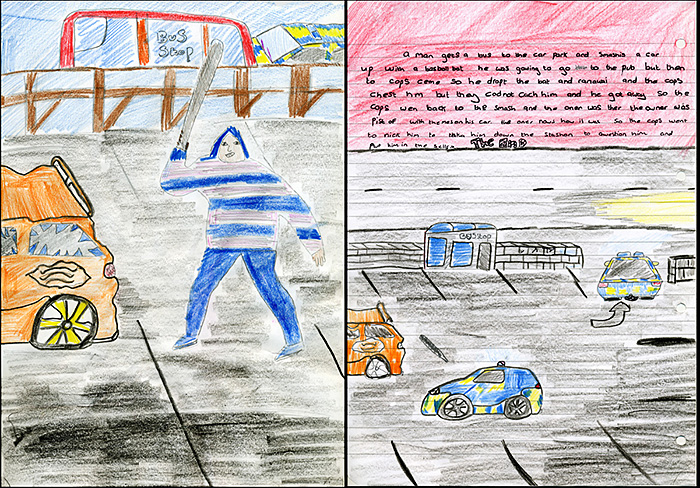
In the Carpark
One young woman felt that her own experience of living off the grid in caves and woodland camps was still too raw to be written down. Instead, she talked to me about it while she concentrated on the simpler tasks of spelling and sentence construction. It was a developing oral history but her memories would be lost when a year later she killed herself in an alcoholic haze.
The sense of déjà vu was to last the full nine years I was with the company.
Quite soon after I started my job went up to four days a week, and every now and then I’d be given an extra day if there was a sudden influx of new trainees. This allowed me the right balance of time and money to move ahead with stripping the old plaster off the walls downstairs in my house. It was probably the most unhealthy job I have ever done as the air was filled with the black coal dust that had been used in the render mix. Bag by bag I got the rubble out to the council tip and started rendering and then plastering the walls. But from that point the rest of the interior decoration would have to wait until I had enough cash put aside to call in a builder to replace the lean-to front of the house. For the moment I had a sink and a gas cooker, but it was more of a shed than a kitchen.
While the house and work were obvious priorities, I wasn’t going to neglect the photography that interested me. I had started building a 4”x5” sheet film view camera in Singapore and needed to finish the front end and find some bellows to complete it. I picked up a lens and the parts I wanted and started shooting. The movements possible with a view camera in isolating focus led me down a whole new avenue of visual exploration.
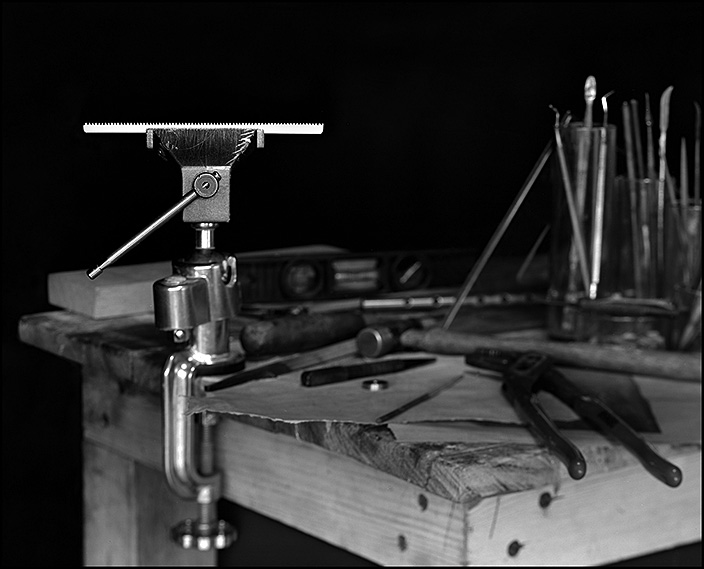
Cutting Teeth
I was on the point of starting up a local photography group on Flickr when I spotted that someone else was trying to do the same thing. They were holding a meeting in Swansea the following week so I dropped my idea and went along to meet them. A dozen of us with a shared interest in photography agreed to go out on a regular basis to some of the key locations around south Wales. It was helpful in getting to know more people and in having a lead in to places I might not have discovered on my own.
My growing interest in the history of photography and the gradual development of the technology and mechanics led me to buy a hundred year old camera to refurbish. What I bought was a cutting edge model of the period, a Houghton Triple Victo Whole Plate camera in wood and brass. The negative size was large and made for a good contact print, which meant that absolutely everything had to be correct at the moment of shooting. Though if it wasn’t there was usually plenty of scope for cropping.
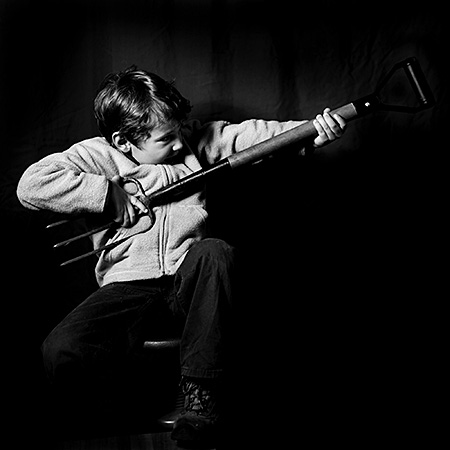
Eddie Rockstar
However, it wasn’t going to work until I had replaced the bellows, which would have been quite expensive given the size. I’d already made a small bellows for a wooden camera in Singapore, but this was at a different scale. There was a lot of help online for designing and making them so I figured I should give it a go. It took three attempts to get a good result that was lightproof and flexible, and would compress well enough to close the camera. Once I showed off the results it was probably inevitable that a friend in the US who was also refurbishing view cameras would ask me to make a set for him. Scott was very encouraging when he saw the first one and soon requested another.
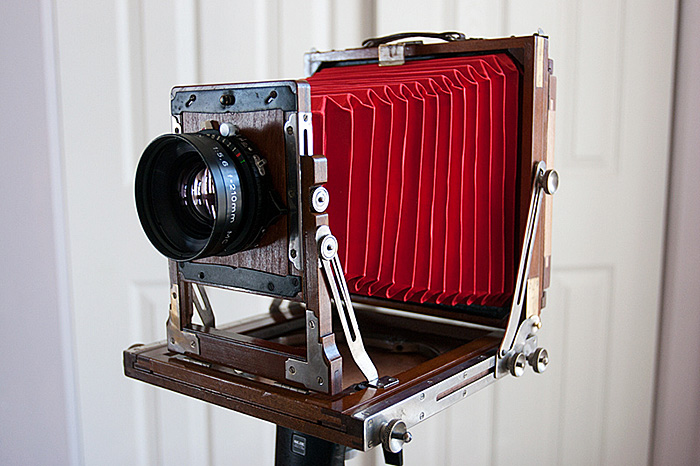
Asunama 5x7
I was also exploring other camera types, particularly post-war folding cameras (such as my father had used) and twin lens reflex or TLR cameras. Folders were part of an early consumer boom while TLRs had been popular with press photographers. By and large they shared the same kind of shutter and lens, and since many of those on the market had not seen much use in a generation they often needed some servicing or repair. The way that shutters became more accurate as they became smaller was intriguing, testament to an increasing refinement in mechanical technology throughout the twentieth century. I would sometimes take in the cameras of friends for repair.
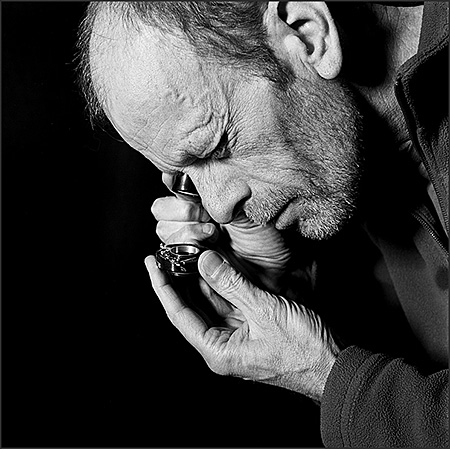
Self
The more time I was spending at my workbench the more I felt the need to get out, but most weekends there was very little going on. Sometimes I’d just take a chance and see what came up. One such day in July 2009 took me to Llandovery where I came across some street performers. After shooting a roll I had a chat with Sian Brown who led the group and they invited me to shoot another event that was coming up in a few weeks.
I met up with them several times and by the end of the year I’d become involved with a youth circus troupe, Organised Kaos, in my own area. Photographing performers is nothing but fun as the subjects themselves have every intention of shining while having a good time, but it can be even better when doing so in a voluntary capacity without the pressure of professional demands. The results were good, and more invitations to shoot performances and public events followed over the years.
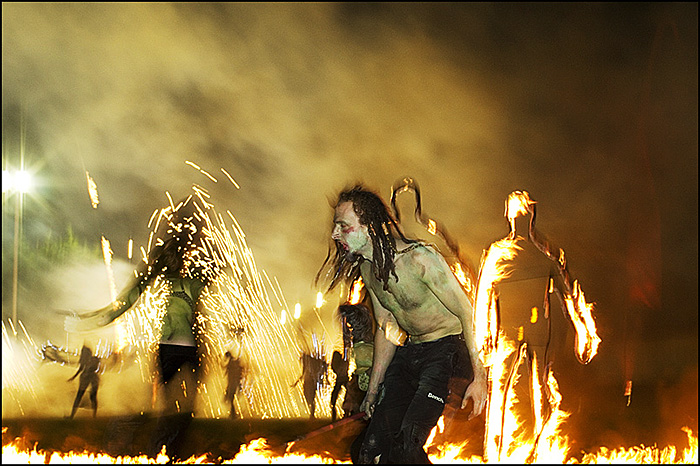
Organised Kaos
Thanks to contacts in Flickr I spotted that a new photography gallery had been opened in Cardiff at the beginning of 2010. The Third Floor Gallery was opened by three guys from Poland and Finland and was dedicated to bringing international exhibitions to the city. They also organised events and gave opportunities for local photographers to show and discuss their work. Over a six year period I gave a dozen talks and found this very useful as a way of presenting my work to a live audience and getting feedback.
However, the online environment was still providing new leads. Some of my large format images had been spotted on a forum by a BBC researcher who invited me to do some stills shooting for a television series. It was just one day’s work, but since the programme, Upstairs Downstairs, was being shot in Wales it was a convenient gig to fit into my working week.
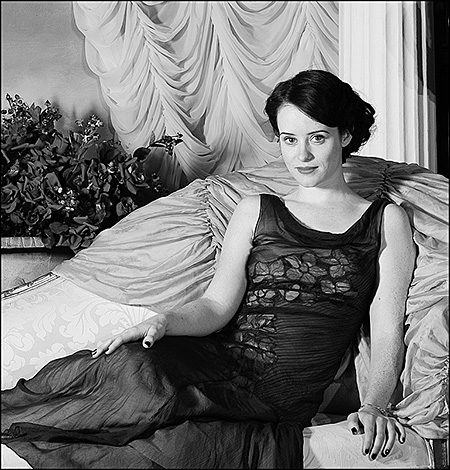
Claire Foy
During the summer an old friend dropped by who I hadn’t seen for ten years. Maria was the eldest daughter of Adri’s Uruguayan friends and was the one who first recognised me from the bus stop. She had been a very good singer at the time and was now recording professionally. She was trying to establish an agency deal here in the UK and came by for a couple of days with her boyfriend. We had a nice time and I was able to profit from her visit with some portrait sessions. She invited me to stay in Montevideo if I could get away during the winter.
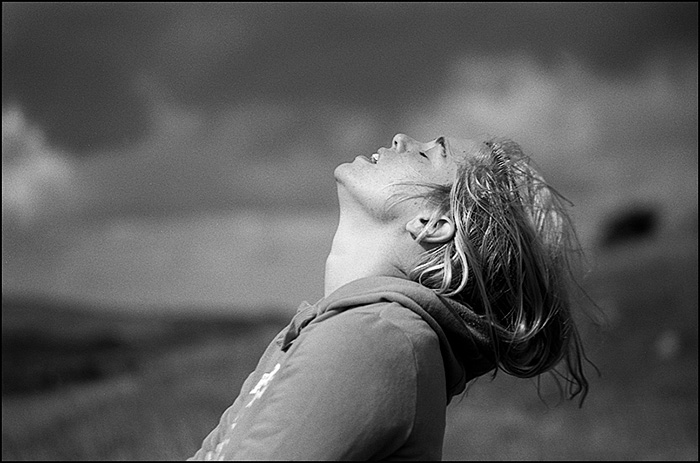
Song
I was still a long way from having enough money to complete the building work as I was still on a four-day week, so I set about planning the trip. I’d been to Italy every other year, but it seemed like a good idea to go south for Christmas, especially as it would be the first chance I’d had of visiting South America. I shot musicians whenever possible and it looked like an opportunity to build up a portfolio of the music scene in Montevideo.
The best laid plans don’t always work out of course, and when I arrived in Uruguay in early December I only got to see Maria briefly in the first twenty-four hours and she then disappeared. This actually proved to be to my advantage as it gave me more time to get to know Sofia and the rest of her family and to shoot some circus performers. The resulting shots from the trip also provided material for one section of the first book I produced, covering street photography in three different cities on three continents: Singapore, Bologna, and Montevideo.
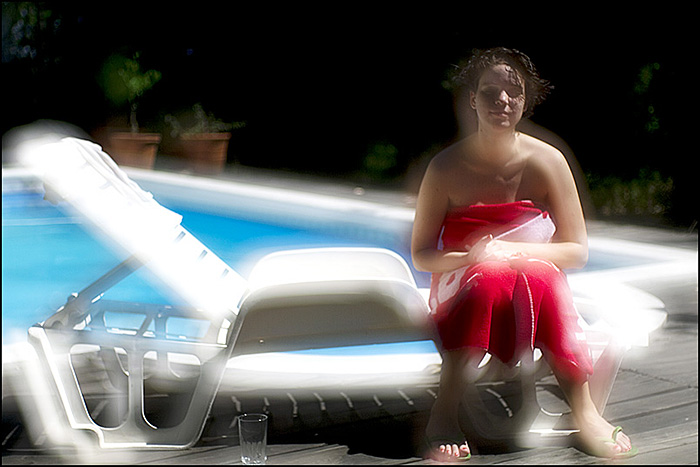
Punta del Este
Shooting the street means different things to different photographers. Some look for visual puns and unusual juxtapositions of people, transport, or signs and graffiti. I’m more interested in observing the moments of reflection of people in their environment. It’s one of the reasons I often shoot musicians and performers since they select their own stage backgrounds to ensure that their public will see them in a good light.
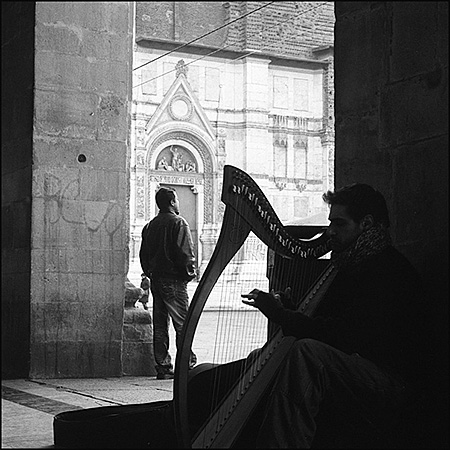
Harpist
What interests me though, is not so much the content of an image as how the subject matter can be transformed by light and shadow.
There once was a painter, Claude Monet
Who painted a haystack three times a day.
“It might not seem right
But I’m only interested in light,”
Was all that the painter would say.
Often repeated by an art teacher I had known to emphasise what he saw as the essential point underpinning the work of the Impressionist painters. Composition and content are sometimes considered in opposition to one another, but it is often the quality of light that makes a shot successful. Reflection and shadow are, (apart from your feet and the camera itself) like construction materials for a photographer. They help to highlight areas or points of interest within the composition, but another method for doing so is to play on differential focus, selectively defocusing any subsidiary content.
I’d started using single element meniscus lenses when I was in Singapore and had had three cut for me by an optician to use on a 6x7 camera I’d made. However, those particular lenses didn’t fit well on a twin lens reflex so I started looking for other lens elements to try out. I was in the middle of writing a book of one hundred photos that I’d taken in Wales over this period, and while I had many sharp shots and soft-focus pinhole shots I wanted something that would combine the best of both. I settled on making up a new lens system for one of my TLR cameras which showed great potential both for portraits and cityscapes. This enabled me to get the final shots I wanted for the book.
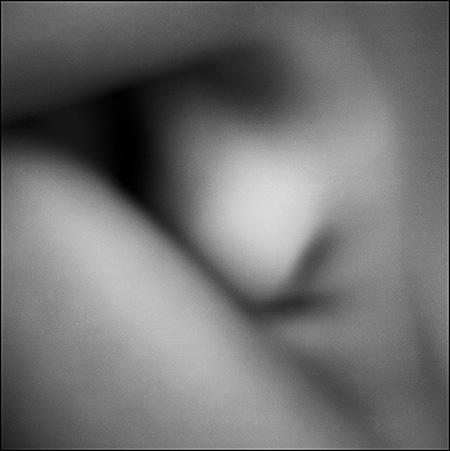
Soft Focus
Media continues to change and the past forty years has perhaps seen more changes than the previous five hundred. Print had become a highly stable medium, but the advent of film and television changed the perception of each generation that grew up with it. The same was occurring with the World Wide Web, which was expanding its reach much faster than print or radio had ever done. Although I’d printed my first book and limited the access to those who could pay for it, I put the second one online directly. It might not be ideal to look at images on a mobile phone on account of the size reduction, but compatibility of systems counts for more than any individual quality when it comes to networking.
One particular project that started in 2012 was following the World Naked Bike Ride in Cardiff each year. I found out about this through a contact at the gallery. As an ex-cyclist I have a lot of sympathy for the way the group is trying to raise awareness of safety issues for cyclists. After all, cyclists are not generally given much attention, but there’s no doubt that when they are naked people do take notice. The riders also have a lot of fun.
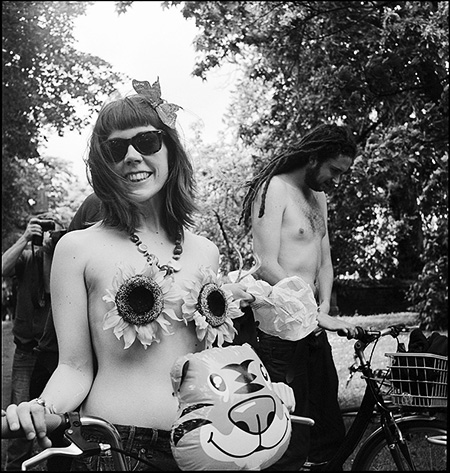
Sunflowers
I went back to Italy four times over the period but I also began working a permanent five day week. As a result most of my shooting was when I went away, but this also meant I could get a bank loan to rebuild the lean-to. Eventually the building work was completed, the kitchen installed and the walls painted.
And that was it, for under the burden of continued mismanagement the training company collapsed in on itself and several teachers were made redundant. The senior manager had pointed out to me some years earlier that my classroom job teaching Literacy and Numeracy to teenagers was basically “not worth getting up for in the morning”, so it was hardly a surprise that they lost the contract.
We had about six months warning and as I took stock of my skills I thought it might be a good idea to start working on some sculpture again as I would likely have the time free. It felt strange to dig out the old tools and pick up fresh modelling materials, but I soon found avenues of expression to follow and I just needed to get back up to speed.
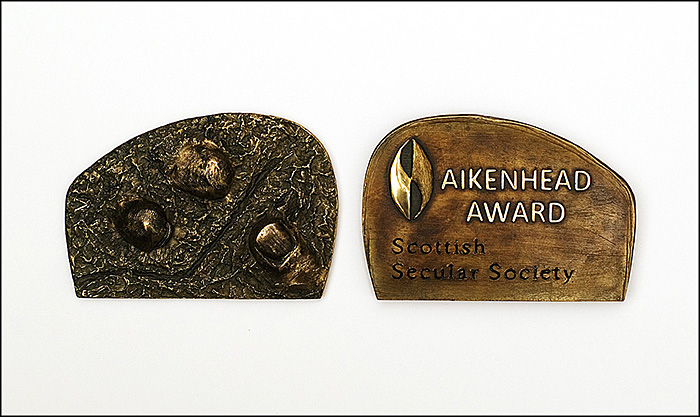
Aikenhead Award
I’d been involved with a secular society for some time and offered them a medal design for a prize they were planning to award. Our discussions went smoothly and before long even the bronze foundry had offered to do the casting for free for a good cause. This prompted me to get in touch with the British Art Medal Society again and they offered me a medal commission as well. It was interesting to be able to work on these very different strands in the visual arts, photography and sculpture, at one and the same time.
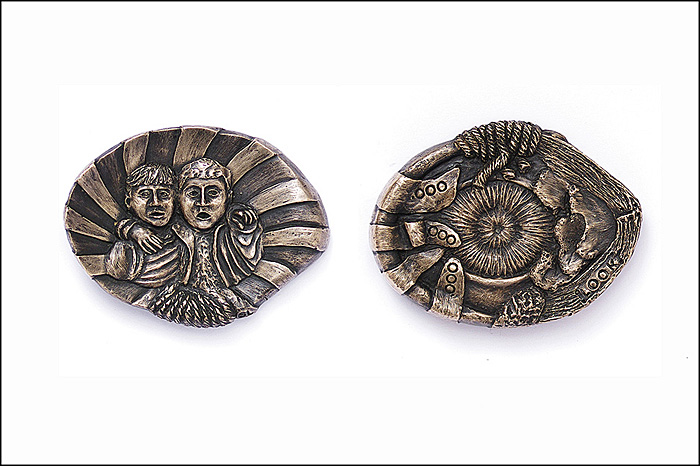
L00K
When I left the training company my colleagues bought me a three month supply of coffee and a bottle of wine which went down very well, but I also needed a gift to myself to mark the occasion. I’d sold my alto sax along with a few other items when raising the final funds for the building work on the house, and in any case my breathing was no longer as strong. I bought a guitar and started to bake bread again.
Teens are hardly renowned for expressing their feelings to adults so when I overheard one of the class saying, “He’s alright, he is”, I took it as a feedback win. It was much appreciated although, “He’s brainy as fuck” was most definitely an exaggeration. But it was as positive as anyone could wish for when a student passed me a comment from her friends, “Oh I love Sandeha, what a fucking legend.”
That was nice.
| Early Days | Late Teens | Bilbao to Copenhagen | London to Cambridge |
| Bologna to Swansea | Salalah to Singapore | Wales | Untitled, Unfinished |